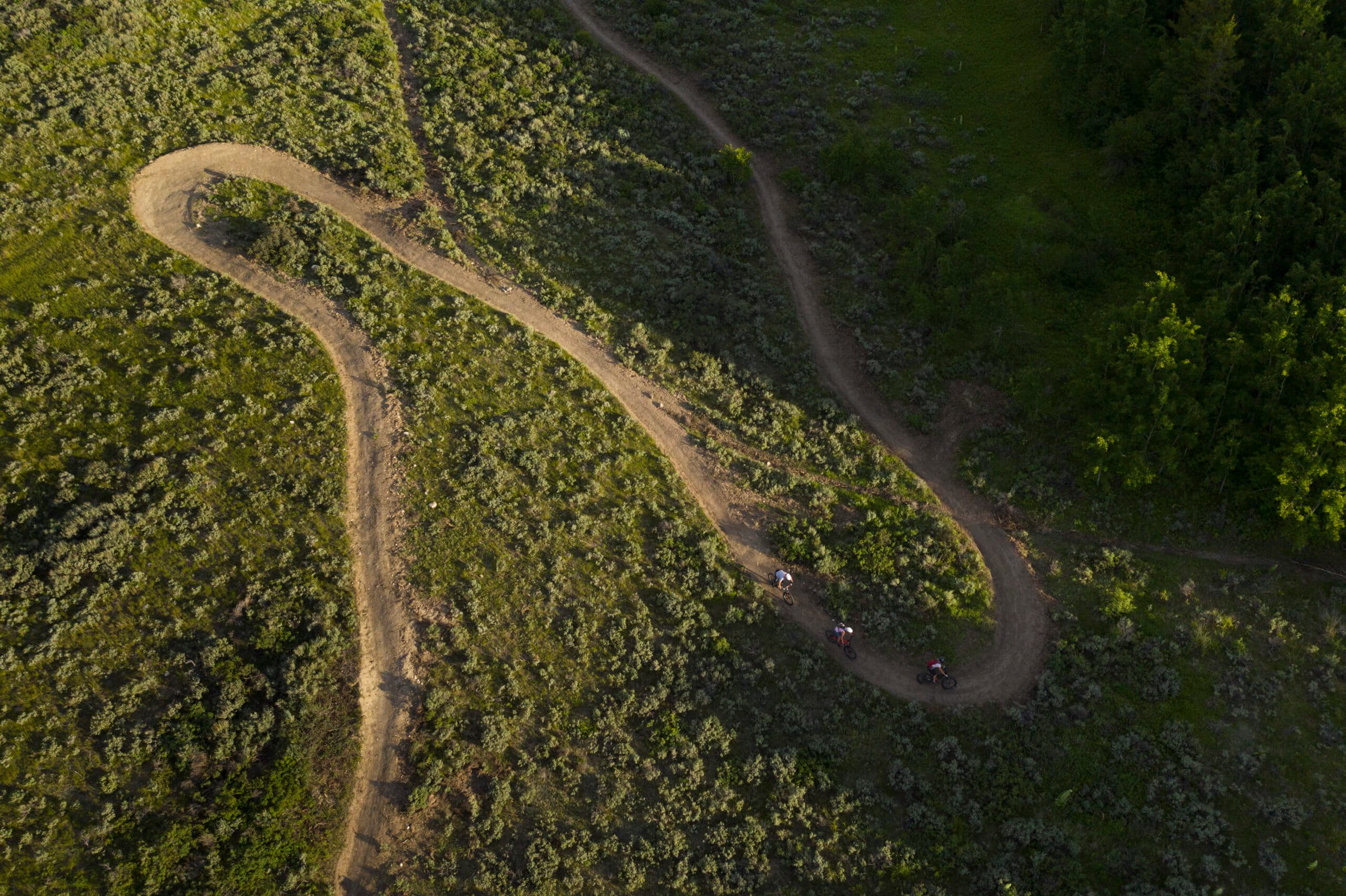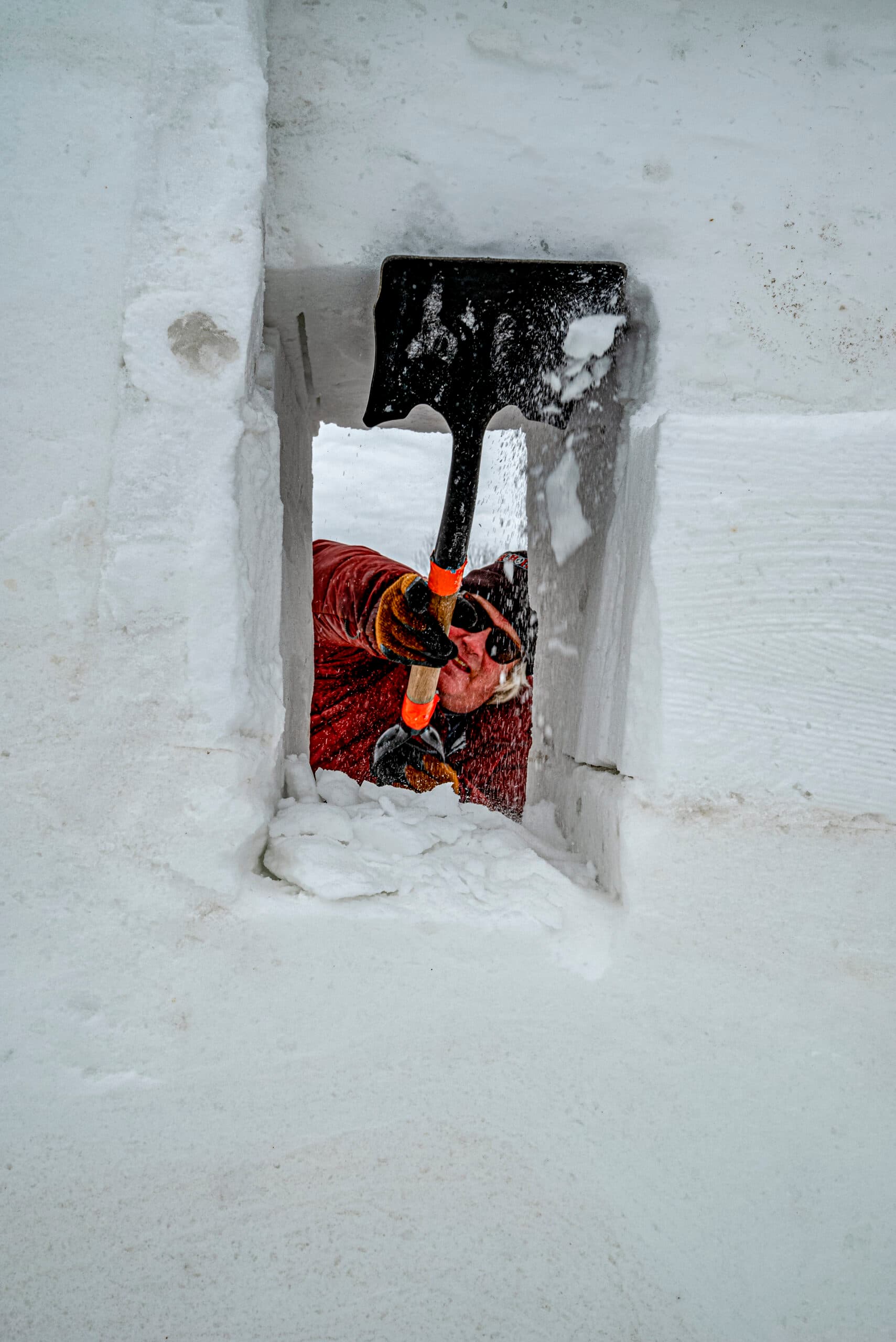From Biffing to Buffed

Fresh off of two years spent in Bend, Oregon, navigating singletrack trails rolling through forests of ponderosa pine, I landed on Teton dirt with my Mongoose mountain bike from college.
The year was 1996 and the smooth Oregon trails had certainly hooked me on the sport. My boyfriend, now husband, Justin, and I took a hard-earned $600 between us (money we acquired that winter working as snowboard instructors at Grand Targhee) into Big Hole Mountain Bikes on West Little Avenue in Driggs and bought our first real GT mountain bikes—complete with coiled front suspension forks—from Dyke Morris. At the time, shop tech Tom Burlingame handed us a copy of Morris’ book “Mountain Bike Rides of Teton Valley, Idaho” (coined by locals as the “Get Lost with Dyke” book). Then, off we went expecting an intricate network of buffed-out trails on which to test our new rides.
Boy, were we wrong.
The perfectly groomed trails of Oregon were a day-dreamy contrast to Tetons Valley’s riding, complete with hike-a-bikes, cow trails, and rocky descents where we’d either walk our bikes or come home with bloodied forearms and shins. Sometimes both. To reach the Expert Loop of the Big Hole Challenge (a “three-potato”-rated ride in Morris’ book) you’d take the “second trail on the right immediately after the second cattle guard” on Horseshoe Canyon Road. The existing trail (now the beautifully groomed Channel Lock) was a “two-track climb up a small valley through meadows and wildflowers, marked by brown fiberglass U.S. Forest Service stakes,” explains Morris in his book. “[The ride] features a highly technical steep descent down a badly eroded old mine road.”
This type of riding was indicative of what we’d battle through just to get in some fun and what a core group of riders were tackling years before our arrival.
Saddle Up, Cowboy
“I remember the first time I ever saw [mountain] bikes that had a five-speed rear end,” says Alta resident Geno Forsythe. “Four guys came into town from Marin County, California, and ‘rode’ up to Alaska Basin on those bikes.”
Geno talks about the early eighties, when Dan Daigh owned the very first bike shop at Cottonwood Corner in Driggs and hosted the “No Wimps Race.” The race started somewhere around the Yellow Rose subdivision in Alta, went up the Bustle Creek two-track to the Targhee road, and then descended down a steep incline into a mudhole before ending in Teton Canyon.
The creativity needed to link roads and trails into rides filtered out a small posse of diehard riders on rigid bikes with no shocks. “I remember rides where my body was shaking so bad, I couldn’t even see the trail,“ says Forsythe. “And, there was no way you could ride two days in a row.” Instead, he and his friends, who included one of the only women riders at the time, Brooke Saindon, needed a day of rest in between, not only for muscle recovery, but also to heal their trail-encountered wounds.
Still, riders like Johnny Lawless, who rode in jeans and cowboy boots with caged pedals, could wheelie up some of the steepest, rockiest terrain. “He’d be huffing and puffing up some hill on one wheel forever,” says Saindon. “Then, you’d come around the corner and he’d be splattered across the trail.”
On the hottest days, the crew would reconvene after rides in the Hillman’s parking lot (now, the Driggs Community Center building) to drink beer alongside Lawless who had already retired his Levi’s for boxer shorts … and cowboy boots.
Down for the Challenge
“In 1995, my brother drove out from Minnesota and we went directly over to Moosely Seconds in Wyoming and bought him a maroon Giant ATC mountain bike,” says Victor resident and former Habitat bike shop tech, Troy Olson. The two men headed back over the pass and began biking—and hiking—up Pole Canyon in Victor. They never made it to the top. “It was a total hike-and-bike! The gear was terrible and the trails were steep as shit,” says Olson.
Today, Olson, Mitch Prissel, co-founder of Habitat in Driggs, and Mike Lien, hydrologist for Friends of the Teton River, are board members of the Teton Mountain Bike Alliance (TMBA), a low-key organization focused on preserving, protecting, and promoting mountain biking on public lands throughout the greater Teton region. During our interview, we chuckled together about the Run, Ride, and Rattle event hosted by former Teton Valley resident Sean Doyle. At this event, about twenty-five athletes ran from the northeast corner of Victor up to Mud Lake. There, they grabbed their bikes and biked downhill to the frontage road and back to Victor to Doyle’s yard where 50-gallon drums filled with cans of PBR awaited them. Next, each athlete had to chug six beers to complete the race. The person who finished last was outfitted with Doyle’s dog‘s shock collar and forced to run through his invisible electric fence. Olson claims he never wore the collar …
Another friendly challenge involved completing a round-trip ride on the Aspen Trail as an out-and-back without putting your foot down—“cleaning” everything from creek crossing and technical rocky sections to the brutal two-track climb out of Darby Canyon. Rumor has it that Olson, Dave Lien (Mike Lien’s brother), Kelly Lee (Tetonia resident and former mountain bike racer), and Glen Gresly, former owner of Tony’s Pizza and Pasta, were the only riders to successfully do it.
“It’s mind blowing what we used to ride on full-rigids,” says Olson. “But today, we have buffed out trails you can actually ride those bikes on.”
Last summer, at age 47, Olson proved it by riding his vintage ’86 Schwinn Mesa Runner with a full-rigid frame and cantilever brakes on the trails at Grand Targhee. He took the bike out Andy’s Trail, down Colter’s Escape, up Rocky Mountain Highway, and down Mill Creek to Teton Canyon. “It hurt while I was riding,” he says of his adventure. “And, you don’t go anywhere as fast as you do on today’s full-suspension bikes.”
After years of riding, pushing, and hiking their bikes alongside other trail users—like dirt bikers and horseback riders—Olson, Prissel, and Mike Lien aim to wrangle all user groups into a unified vision of trail expansion, resurrection, and preservation. They’re doing this by working alongside other organizations like Mountain Bike the Tetons (MTB), Teton Valley Trails and Pathways (TVTAP), and the Teton Basin Ranger District, drawing from their dedicated group of volunteers to improve the trail experience for all.
Biking a Tightrope
Mountain biking has come a long way in Teton Valley, and the immaculate trail system we have today didn’t appear through magic. Long before the comprehensive Forest Service Travel Management Plan was established in 2008, Teton Valley bikers were not restricted to designated routes and sometimes they linked cow and game trails to double track and roads.
At the time, Wendell Stam, owner of Big Hole Sports (he bought the shop from Dyke Morris in 1997), rallied a renegade group of riders to clear cow trails in Horseshoe Canyon.
“It started with Rasta’s [Matt Mullenbach] ‘Burg Trail,’ a section of trail Dyke had used in his original Big Hole Challenge race loop,” says Stam. “We went from salt lick to salt lick and made the trails rideable.” He explains that the group found and cleared another trail extension, calling it “Cody’s Loop,” after his deceased dog who is buried “somewhere in the Big Holes.” Cody’s eventually linked to Sodbuster and then to Woods Hollow.
What went from the simple clearing of brush, however, turned into a carefully calculated rerouting of cow trails into passable routes for all users. And while the group’s expanded efforts weren’t exactly permitted, they weren’t exactly illegal either. At the time, the demand for bikeable trails was high and formal restrictions were ill-defined.
“As a shop owner, I sort of stepped up and took on the civil disobedience role,” says Stam. “The stuff we built [in 2002] became part of the culture of riding in Teton Valley.” This prompted an unofficial cooperation between trail ambassadors and the local Teton Basin Ranger District of the Caribou-Targhee National Forest. Still, some considered the crew’s reroutes the tipping point, while others commended their perseverance to mobilize a community viewed as an anomaly.
In 2005, a letter from Rob Marin, former GIS mapper for the Teton Basin Ranger District, urged the TVTAP trails committee to get organized around mountain bike trail expansion. On October 4, 2005 a “meeting of the minds” ensued, led by the trails committee and held at the residence of Dan Powers and Lynne Wolfe. To the table rallied local business owners, nonprofit leaders, Grand Targhee Resort representatives, and volunteer trail builders.
Nevertheless, Stam continued his underground trail building, selling his shop the next spring, and using his newfound downtime to create the backbone of what is now considered the Southern Valley Trails. First came Nemo, and then Grumpy’s, two trails that were eventually absorbed into the comprehensive plan, but only long after Stam had been issued a ticket for his surreptitious efforts.
Together, We Ride
“We all sat around and nerded out on a map,” says Geordie Gillett, general manager of Grand Targhee Resort, when recounting the trail meetings that followed. “We wanted to connect Mill Creek to Dead Cow to the Aspen Trail. Then Troy [Olson] had this crazy way to get from the Aspen Trail to Victor … and, we took it to the Forest Service.”
The plan didn’t get a stamp of approval, but that didn’t thwart the group’s momentum.
“Riders were starting to get organized and there was a perceived need for a dedicated mountain bike organization, one focused on dirt trails,” says Wolfe. So, former bike shop owner Scott Fitzgerald and Dave Trennis, an active member of the International Mountain Biking Association (IMBA), came up with a plan to approach IMBA and seek national-level support. But first, they had to form an official mountain-bike centric organization.
In March of 2013, Mountain Bike Teton Valley (MBTV) was created with an initial membership drive organized by Fitzgerald’s Bicycles in Victor. Soon after, a board comprising many of the original 2005 meeting attendees was formed. That fall, MBTV was officially designated an IMBA chapter and granted 501c(3) status; the chapter was later amended to incorporate Jackson Hole and the entire Teton region. This prompted a name change to Mountain Bike the Tetons (MBT) and the inclusion of Wyoming-based board members.
Today, MTB is led by executive director Tony Ferlisi and board president Lynne Wolfe.
“We’re in a really great spot right now with a pretty well-rounded trail network in Teton Valley,” says Ferlisi. “We have one of the best areas for big adventure mountain bike rides in the Lower 48. Couple that with beginner and immediate terrain [something he and others on the crew have been working to integrate] and we’ve hit the sweet spot.”
MBT operates a full-time seasonal trail crew from May through September. Together with volunteers, the crew maintains over two hundred miles of trail; they built six miles of new trail last season and are aiming for eight miles this year. The organization hosts monthly volunteer trail days, partnering with local businesses like Citizen 33 Brewery, Kate’s Real Food, Wildlife Brewing, and Moonshine Liquor, Beer, & Wine to provide post-work food and drink for the posse.
It’s All Downhill from Here
Ask any longtime resident rider when Teton Valley officially made it onto the “destination mountain biking map” and they’ll attribute it to the efforts made by a talented crew up at Grand Targhee Resort.
“What Harlan [Hottenstein] and Clay [Curley] of the Teton Freedom Riders did in Wyoming sparked the whole momentum,” says Mike Lien. “Then, Targhee took it to the next level.”
The Freedom Riders, a group of enthusiasts missioned to grow mountain biking in Teton County, Wyoming, has been constructing downhill trails on Teton Pass since 2004. The forefathers of extreme mountain biking in the region, they held the pulse on the scene long before the sport was fully embraced. Harlan and Clay, alongside Andy Williams, manager of events and trails at Grand Targhee, created a resort mecca for both downhill and cross-country riding. Head up to the hill on a summer weekend these days and you’re likely to encounter a parking lot that’s nearly as full as that typical of any given ski day.
“The first year I came on board, we started off with a downhill focus,” says Williams. “We built Sidewinder, Buffalo Drop, and Sticks and Stones.” He explains that Geordie Gillett, an avid cross-country rider, gave him free rein to design and build more trails. So, they put together a plan and presented it to the Forest Service in 2010 (and then again in 2012 and 2014), requesting permission for the resort to expand its cross-country offerings from six to eight miles a year. According to Gillett, the resort’s new master plan includes twenty additional miles of trails, which would result in approximately a hundred total miles of bikeable terrain at Grand Targhee.
Today, the resort’s music festivals appear to be just as much about mountain biking as they are about the music, as avid riders travel from all over the region to attend. Add to that events like Pierre’s Hole Mountain Bike Race (August 1, 2020), the Wydaho Mountain Bike Festival (September 4–6, held in conjunction with TVTAP), and the NICA Idaho Interscholastic Cycling League Race (September 12), and the place is teeming with riders all season long.
“You went [to this] from seeing an elusive mountain biker every once in a while,” says Gillett. “Now, lots of cars have bikes, racks, and out-of-town plates. People appreciate the area. They stay; they tell their friends; they spend money here. And it all started in that room [in 2005] when we realized that there were other people like us out there.”
Some Teton Valley riders may have traded their pedal cages and cowboy boots for chest protectors and full-face helmets, but the mission remains the same. And, for me, recalling the day when the Aspen Trail was the “easiest” out-of-town ride was a fun walk down memory lane, noting our collective dedication to the sport. It’s something I won’t take for granted this spring as I pedal my weary legs up some buff singletrack in the Big Holes or out my back door in the north end of the valley. But if you see my car at some elusive trailhead this year, please don’t tell your friends. Some rides still remain a secret.




